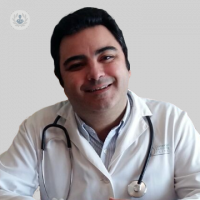Hodgkin's Lymphoma: How to Identify It?
Written by:Hodgkin's lymphoma is a lymphatic cancer. Because lymph tissue is found in numerous parts of the body, Hodgkin's disease can originate almost anywhere but usually occurs in lymph nodes in the upper body such as the chest , neck, or armpits .
This cancer generates an enlargement of the lymphatic tissue, being able to cause pressure on some important structures of the body. The most common form of spread of Hodgkin's disease is through the lymphatic vessels to other lymph nodes. In most cases this disease is spread to the nearest lymph nodes in the body and not distant. It rarely gets through the blood vessels and can spread to almost any other part of the body, including the liver and lungs.

Incidence of Hodgkin's lymphoma
In Spain, in 2016, the incidence of this pathology was 12.3 / 100,000 inhabitants. Each year about 1,500 new cases occur in our country diagnosed by specialists in Hematology. Since many of the people who have it are young, they often live more than 40 years after treatment.
- Incidence: in Europe it is estimated that it has an incidence of 1000 new cases per year per 100,000 inhabitants. Unlike the rest of the lymphomas, its incidence is stable over time.
- Age: Hodgkin's lymphoma presents a bimodal distribution, since frequently the first of the peaks appears in the youth, between the 20 and 35 years, later to diminish. The second peak appears at more advanced ages, from the age of 50, as the rest of lymphomas. It is uncommon to appear before 10 years of age.
- Sex: Hodgkin's disease is more common in men than in women.
- Geographic region: it is more common in developed countries, in Europe and the United States, with the exception of Japan, than in developing countries.
- Socioeconomic level: generally occurs in people with a high socioeconomic level. However, people of low economic status have a worse prognosis. The socioeconomic level explains the geographic and racial differences.
Causes of Hodgkin's lymphoma
There are several causes that can cause Hodgkin's disease:
- Genetic factors: although there are familial cases, the majority of cases with Hodgkin's disease do not have a hereditary origin. However, it is 99 times more frequent in a homozygous twin of an affected subject than in the general population, which supports the suspicion of an inherited factor. What is not clear is the association with the histocompatibility system (HLA)
- Medical history: Hodgkin's disease has only been linked to some congenital and acquired immunodeficiencies (HIV) and autoimmune diseases. They have also described an increased risk in tonsillectomized and appendectomized patients.
- Occupational factors: it is linked to some industrial work related to lead, wood, organic substances, but requires more confirmation.
- Epstein-Barr virus infection: more than half of all patients with Hodgkin's disease have been in contact with Epstein-Barr virus (EBV) because they have had an infectious mononucleosis or have high levels of antibodies against the EBV or virus is present in lymphoma cells.
Symptoms of Hodgkin's disease
There are several symptoms that can lead to the onset of Hodgkin's lymphoma:
- Incidental Detection : The patient may experience a sudden increase in lymph nodes in the neck, armpit or English area, or the specialist may notice a mediastinal mass on a chest x-ray that has been performed for another reason.
- Symptoms B : are general symptoms consisting of an unexplained fever lasting more than 3 days, a loss of body weight in the last 6 months and profuse sweating, usually nocturnal. Of these symptoms, the most important are fever and thinning. Pruritus is not considered as a B symptom, except when it suddenly appears with recurrent, persistent and generalized lymphadenopathy. Pel-Ebstein fever is a rare type of temperature rise for several days, which then disappears for several days or weeks to reappear.
- Painful lymphadenopathy : although lymph nodes affected by Hodgkin's disease are not painful, it is characteristic that the patient has enlarged lymph node pain when he or she ingests alcohol. This is known as the Hoster sign .
Other symptoms are cough, chest pain or dyspnoea, in cases of involvement of the mediastinum, lungs, pleura or pericardium. Asthenia or weakness in cases of anemia due to involvement of the bone marrow is also common.
The patient may also have other, less frequent symptoms depending on the anatomical location affected.
Treatment of Hodgkin's lymphoma
There are several treatments for the Hodgkin's lymphoma. Generally, current treatment plans for Hodgkin lymphoma use new types and doses of chemotherapy and radiation therapy directed to smaller areas of the body.


